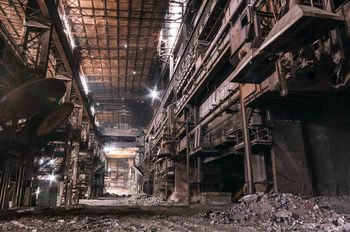Images and Reports from Historic Building Recording at Teesworks Industrial Zone, Redcar July and October 2021
The Environment Partnership, 2022. https://doi.org/10.5284/1090511. How to cite using this DOI
Data copyright © The Environment Partnership unless otherwise stated
This work is licensed under a Creative Commons Attribution 4.0 International License.
Primary contact
The Environment Partnership
No. 1 The Chambers
Bowden Business Village
Market Harborough
Leicestershire
LE16 7SA
Resource identifiers
- ADS Collection: 4434
- DOI:https://doi.org/10.5284/1090511
- How to cite using this DOI
Introduction

This collection comprises images and reports from a programme of historic building recording carried out by the Environment Partnership Ltd between July and October 2021. This work encompassed the former Redcar Iron Works, the Lackenby Steel Works, and the coke ovens and by-products plant at South Bank. The survey area was referred to collectively as the Teesworks Industrial Zone.
The project was conducted on behalf of the Tees Valley Combined Authority and the Teesworks Heritage Taskforce. The principal objective of the survey was to produce an archaeological record of the site, the various plant and buildings, and the processes of materials movement and manufacturing which took place at the different stages of the works.
The Redcar site included Raw Materials Handling facilities, Coke Ovens and By-Products, Sinter Plant, Power Station, Gasholders, Workshops and Offices, and the Blast Furnace.
The South Bank site included Coke Ovens and By-Products plant, the 1950's Service Bunker (Dorman Long Tower), and a range of associated buildings including offices and workshops. The South Bank site was largely constructed during the 1950s by Dorman Long and Company to produce coke from coal in support of the adjacent Cleveland Works. The site included a wharf and raw materials handling facility at which coal was delivered, conveyed, crushed and screened before being carbonised in the coke ovens. The waste gases from the coke ovens were collected and washed at the by-products plant to remove various substances such as tar ammonia and benzole.
Further to the south at Lackenby was a substantial steelmaking plant which included Basic Oxygen Furnaces delivering high-quality molten steel directly to a Continuous Casting plant which include a bloom caster and two slab casters. The Redcar and Lackenby sites were linked by a dedicated rail line which allowed molten iron produced at the blast furnace to be directly conveyed to the converters





